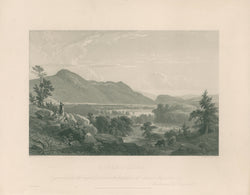
Asher B. Durand. “Dover Plains”. [Dutchess County, NY].
New York, AAU, 1850. 6 7/8 x 10 ¼ (image) plus margins. Engraved by James Smillie. Two small repaired tears in margins not affecting image. Very good condition.
The American Art Union (AAU) is well known today for the thirty-six engravings it published based on the paintings of some of the most luminous names in American art, e.g. George Caleb Bingham, Thomas Cole, F.O.C. Darley, R.C. Woodville, Asher B. Durand, and William Sidney Mount. The association is especially important for the seminal role it played in stimulating American art and for spreading an awareness of this art throughout the country. With its gallery and thousands of subscribers, the AAU probably had more to do than any other force with the success of many of America’s nineteenth century artists and the popularization of their work. The legacy of the American Art Union is immense and its prints are an important part of that heritage.
Asher B. Durand was born in New Jersey in 1796. From 1812 to 1817 he was apprenticed as an engraver to Peter Maverick, becoming a partner and working with Maverick until 1820. He mostly worked on banknotes and in copying English prints. In 1820 John Trumbull was looking for an engraver for his “Declaration of Independence” who would work for $3,000 instead of the $7,000 demanded by James Heath of London. The plate (29 11/16 x 30 1/4) took Durand three years to finish, but this established Durand as an American engraver of note.
Besides banknotes, portraits, the Declaration, and book illustrations, Durand engraved six plates for a projected series (never completed) titled “The American Landscape” and “Ariadne” after another painting by J. Vanderlyn. In 1835, Durand’s interest turned from engraving to painting, and he soon became a leading member of the Hudson River School of artists. From 1845 to 1861, he served as president of the national Academy of Design, of which he was one of the founders.

